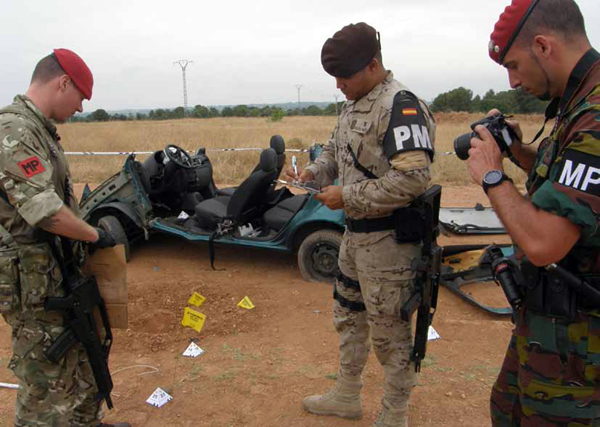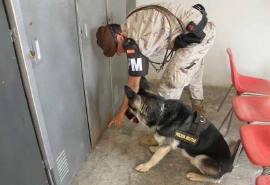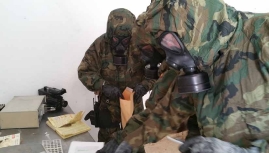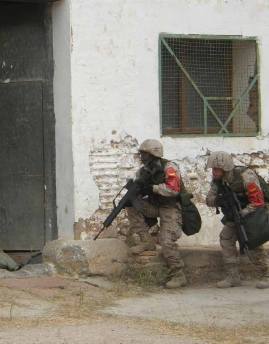- Inicio
- Reportajes
- Detalle de la noticia
Los defensores del 'Azul'
martes 21 de julio de 2015
Número: 017
Liderado por el Batallón de Policía Militar I, reúne en Valencia a policías militares de varios países

Un equipo WIT multinacional en plena investigación de un ataque contra un vehículo
El ejercicio “Ángel Guardián”, que lidera el Batallón de Policía Militar I, reúne en Valencia a policías militares de las Fuerzas Armadas españolas, de Bélgica y del Reino Unido.

Registro de taquillas con un equipo cinológico

Recogida de posibles pruebas en un laboratorio clandestino

Entrada en un laboratorio clandestino simulado para capturar a los líderes de una célula terrorista
En los mapas militares se utilizan símbolos normalizados para indicar las diferentes fuerzas. En este sistema, el color azul se utiliza para las fuerzas propias y amigas, rojo para las fuerzas hostiles, verde para las fuerzas neutrales y amarillo para las fuerzas de origen desconocido.
La expresión «Green on blue» (verde en azul) empezó a utilizarse en el contexto de las misiones de Irak y Afganistán para denominar los ataques por parte de insurgentes infiltrados en las fuerzas de seguridad locales contra las tropas internacionales presentes en el país. Este es un riesgo que se tiene especialmente presente en las misiones de mentorización, en las que la cercanía y convivencia con el personal que se instruye son muy estrechas.
En este tipo de operaciones, el papel de los que se encargan de la seguridad de los instructores es clave, de ahí que en la edición de este año del ejercicio 'Ángel Guardián' —el más importante de Policía Militar (PM) que se realiza a nivel nacional— se haya incluido una estación con este supuesto.
Un ataque de este tipo es una de las situaciones más difíciles de gestionar que se pueden presentar. En ellas, el papel de la PM es, más que nunca, el de ángeles guardianes de sus compañeros.
Los participantes en el ejercicio —casi todas las secciones de PM de las Brigadas de la Fuerza Terrestre, de las Comandancias Generales de Ceuta y Melilla, y del Mando de Canarias, por parte del Ejército; una compañía de Policía Naval de la Fuerza de Protección y un equipo de la Brigada de Infantería de Marina, de la Armada; un pelotón del Ejercito del Aire; una sección de la Guardia Real; otra de la Unidad Militar de Emergencias; más un pelotón de la Royal Military Police del Reino Unido (conocidos como los red caps) y otro del Military Police Group de Bélgica— tuvieron la oportunidad de adiestrarse en supuestos de este tipo.
La protección de la Fuerza es sólo una de las múltiples misiones que los componentes de la Policía Militar pueden asumir en zona de operaciones. Y en este ejercicio, que está impulsado y liderado por el Batallón de Policía Militar I —que pertenece al Cuartel General Terrestre de Alta Disponibilidad de la OTAN y es referente para todas las unidades de Policía Militar del Ejército—, se han reproducido hasta una decena de escenarios, repartidos entre las zonas de instrucción de las bases 'Jaime I' de Bétera, 'General Almirante' de Marines y en el complejo educativo de Cheste, cedido por la Generalidad valenciana (todos situados en la provincia de Valencia). En ellos han podido desplegar el abanico de capacidades con las que cuentan.
Riesgo NBQ
La captura de los líderes de un grupo criminal que se dedica a la fabricación de armas químicas y la recogida de evidencias de su actividad delictiva podría ser una de las misiones encomendadas al personal de la PM en zona de operaciones. Sus integrantes cuentan con la formación necesaria para desarrollar estos cometidos de tipo policial, y tuvieron que demostrarlo en un escenario como este. La situación se complicaba porque, durante la intervención, algo estallaba en el laboratorio con el consiguiente riesgo de contaminación. Al grito de «gas, gas, gas», sabían que había llegado el momento de colocarse el Equipo de Protección Individual (EPI) para poder completar la misión.
El capitán David G. S. , encargado de dirigir esta simulación y jefe de la 1ª Compañía del Batallón, fue testigo de las diferencias y coincidencias en los procedimientos entre la Policía Naval o Aérea, o frente a los que emplean otros Ejércitos. Precisamente este es uno de los aspectos importantes del ejercicio, el que posibilita el intercambio de procedimientos y el aprendizaje mutuo.
El despliegue se completaba con la colaboración del Regimiento NBQ 'Valencia' 1, que montó su Estación de Descontaminación; por ella tenía que ir pasando el personal que había estado en contacto con posible material contaminado, después de finalizar la intervención.
Parte del equipo
La integración dentro de un equipo de investigación especializado en armamento, como son los WIT (Weapons Intelligence Team) puede ser otro de los destinos de un policía militar. Este Equipo está formado por un especialista de Inteligencia, otro de Operaciones y un tercero de Explosivos, a los que se une un policía militar. Su aportación es fundamental para recoger pruebas tras un ataque.
El equipo se forma ad hoc cuando hay que realizar una investigación, y se encarga de comprobar si los procedimientos establecidos han funcionado o si habría que revisarlos, ver si el enemigo ha cambiado su forma de actuación y mantener la cadena de custodia de las pruebas para ponerlas a disposición judicial.
Su labor es discriminar evidencias, «por eso tiene que ser un personal muy especializado», explica el sargento 1º José Mª G. H. , que cuenta con el curso WIT de la OTAN. Él fue el encargado de dirigir la estación para la actuación de los equipos WIT, en la que se presentaban tres escenarios: un vehículo atacado con un Artefacto Explosivo Improvisado, un accidente de autobús en un pueblo que un insurgente había aprovechado para colocar un artefacto en medio de la confusión y una explosión controlada.
Sección multinacional
Este año se constituyó una Sección Multinacional formada por un pelotón de la Royal Military Police del Reino Unido, un pelotón del Military Police Group de Bélgica y otro del Batallón español.
Dentro del Ejército británico, existe una Brigada de Policía Militar, que incluye la Royal Military Police, la Military Provost (que se encarga de las detenciones y de las prisiones militares) y los que se dedican a la seguridad de las bases. El capitán británico Dan Oakland destacó que el ejercicio había resultado una buena preparación de cara a operaciones y para focalizarse en las misiones propias de la Policía Militar, además de una buena oportunidad para trabajar con sus colegas españoles y belgas. «Al principio éramos tres unidades y ahora somos una», destacó.
Una sensación compartida por el suboficial mayor Walter Verbeke, jefe del pelotón belga, quien destacó que las actividades habían servido para «limar diferencias» entre todos ellos. En el caso belga, los policías militares no alcanzan los dos centenares para un total de 38.000 militares.
PROTECTORS IN BLUE The “Guardian Angel” exercise, led by the 1st Military Police Battalion, brought to Valencia military police personnel from Spain, Belgium and the UK Military maps use normalised symbols to identify the different forces. In this system, blue includes own and friendly forces; red is used for hostile forces; green means neutral forces; and yellow indicates forces of unknown origin. The expression “green on blue” started to be used in the context of the Iraq and Afghanistan missions to designate attacks against international troops by insurgents who have infiltrated the local security forces. The risk is especially high during training missions due to the close contact with the personnel being trained. In those operations, the role of those who watch over the safety of trainers is therefore crucial. Which is why this year’s edition of “Guardian Angel” – the most important exercise carried out by the Military Police in Spain – has included this scenario. An attack of that nature is one of the most difficult situations to manage. In that context, MPs play the role of guardian angels for their colleagues – even more than is usually the case. Participants in the training exercise included personnel from the Army (almost all the MP sections from the Land Force Brigade, the General Commands of Ceuta and Melilla and the Canary Islands Command), the Navy (a Naval Police company from the Protection Force), the Air Force (a squad), the Royal Guard (a section) and the Military Emergency Unit (a section), along with two squads from the British Royal Military Police, known as the Red Caps, and the Belgian Military Police Group. But force protection is only one of the tasks undertaken by MPs in the theatre of operations, and the exercise allowed them to practise other skills. It included ten different scenarios spread around the Valencia province, in the training grounds of the bases in Bétera and Marines (“Jaime I” and “General Almirante”, respectively) and in the Cheste educational complex, on loan from the Valencian regional government. It was organised and led by the 1st MP Battalion, which belongs to the High Readiness Land Headquarters and serves as the model for all other MP units in the Army. NBC risk MPs can also be required to capture the leaders of a criminal gang which manufactures chemical weapons and to collect evidence of its activities. They have been trained to carry out that kind of policing task and had to apply that training in one of the scenarios. The operation was complicated by something going off in the laboratory, which meant that there was a risk of contamination. When someone shouted out “gas, gas, gas”, they knew it was time to put on their personal protective equipment (PPE) in order to complete their mission. Captain David García Sedano, chief of the 1st Battalion Company and in charge of this simulation, noticed MO differences and similarities between the Naval Police and the Air Force Police and also between the different armies. One of the most important aspects of the exercise was that it made it possible to exchange techniques and learn from each other. The 1st NBC Regiment “Valencia” collaborated in the exercise by setting up its Decontamination Station. Personnel who might have been in contact with contaminated material during the exercise would go through it once their participation was over. Part of the team MPs also work as members of WITs (Weapons Intelligence Teams) which, as their name indicates, are investigative teams specialised in weapons. They are made up of three specialists in intelligence, operations and explosives as well as an MP. The contribution of the latter is essential to collect evidence after an attack. The team is put together ad hoc when an investigation needs to be carried out. It verifies that established procedures have worked and may suggest their revision. It checks whether there has been any change in the enemy’s MO. Furthermore, it keeps the chain of custody of the evidence to be forwarded to the judge. WITs determine what constitutes evidence “therefore its members have to be highly specialised,” explains Staff Sergeant José Mª G. Herrero, who has done the NATO WIT course. He was responsible for running the WITs station, which presented three scenarios: an IED attack on a vehicle; an insurgent taking advantage of the confusion caused by a bus accident in a village to place an explosive device; and a controlled explosion. Multinational Section This year saw the setting up of a Multinational Section made up of squads from the British Royal Military Police, the Belgian Military Police Group and the Spanish Battalion. The British Army has an MP Brigade which includes the Royal Military Police, the Military Provost (charged with arrests and military prisons) and personnel to maintain base security. British Captain Dan Oakland stressed that the exercise had been useful to prepare for future operations and to focus on tasks specific to MPs, in addition to providing an opportunity to work with Spanish and Belgian colleagues. “We started off as three separate units, now we are only one,” he remarked. Chief Petty Officer Walter Verbeke, chief of the Belgian squad, agreed. He highlighted that the activities had been useful to “smooth off the rough edges” between the different groups. In the case of Belgium, there are less than 200 MPs for 38,000 soldiers. [Captions:] Multinational WIT investigates an attack against a vehicle Searching lockers with the dog team Collecting possible evidence at a clandestine lab THE LEGAL FRAMEWORK Military, Naval and Air Force Police (MP, NP and AP, respectively) are charged with the security, custody, escort and supervision of military transportation and convoys as well as the protection of Armed Forces personnel, according to Royal Decree 194/2010 (26 February), which deals with the “Norms governing security in the Armed Forces”. The decree also establishes that they can control traffic outside military facilities in the absence of traffic wardens or to assist them in their task, after obtaining authorization from the relevant body and coordinating their intervention with the wardens. Article 31 of the Royal Decree notes that MPs, NPs and APs can support each other and the State Security Forces if the latter request it, carrying out the responsibilities they have been trained for and always within the limits of their powers and legally formulated procedures. MPs in combat support units – to be more precise, operational support – assist commanders and combat units by carrying out the following activities: mobility support (which includes investigating traffic accidents and incidents and drafting reports to determine their cause and assist in the judicial process), security, policing and arrest. Law enforcement agents On the other hand, members of the Armed Forces serving as MPs, NPs and APs have law enforcement powers when carrying out their duties, according to the third additional disposition of Law 39/2007 (19 November) on the military profession. In this regard, Order DEF/316/2015 (23 February), published earlier this year, approved the means of identification that members of the Armed Forces must wear or carry in order to be recognized as law enforcement agents. The Order establishes four means of identification: The bracelet, which provides the military agent clear visual identification. The high visibility vest, which makes him/her more visible thereby granting him/her protection by showing his/her position; it should be employed in traffic control missions, interventions during natural emergencies or whenever its use might prevent occupational hazards. The personal identification badge, an eight-pointed star identifying the bearer as a law enforcement agent and displaying a unique personal identification number. And the personal identification card, which constitutes an additional means of identification when he/she is in uniform and the only means of identification when he/she is in civilian clothes. In international missions, the means of identification have their own regulations which might be based on these guidelines, on those specific to the operation in question and on the rules of each organisation, hosting nation or international coalition in charge.UNIDADES DEL EJÉRCITO
- Araba Álava |
- Albacete |
- Alicante |
- Almería |
- Asturias |
- Ávila |
- Badajoz |
- Barcelona |
- Burgos |
- Cáceres |
- Cádiz |
- Cantabria |
- Castellón |
- Ceuta |
- Ciudad Real |
- Córdoba |
- A Coruña |
- Cuenca |
- Girona |
- Granada |
- Guadalajara |
- Gipuzkoa |
- Huelva |
- Huesca |
- Islas Baleares |
- Jaén |
- León |
- Lleida |
- Lugo |
- Madrid |
- Málaga |
- Melilla |
- Murcia |
- Navarra |
- Ourense |
- Palencia |
- Las Palmas |
- Pontevedra |
- La Rioja |
- Salamanca |
- Segovia |
- Sevilla |
- Soria |
- Tarragona |
- Santa Cruz de Tenerife |
- Teruel |
- Toledo |
- Valencia |
- Valladolid |
- Bizkaia |
- Zamora |
- Zaragoza



